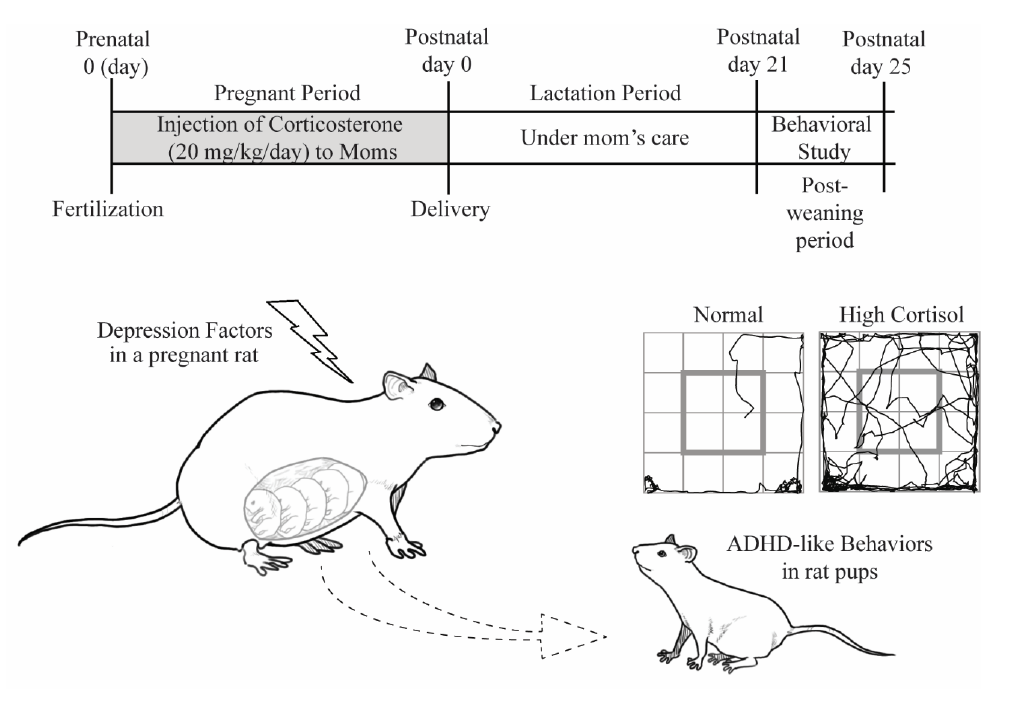Articles
Article Tools
Stats or Metrics
Article
Original Article
Exp Neurobiol 2021; 30(1): 87-100
Published online February 28, 2021
https://doi.org/10.5607/en20057
© The Korean Society for Brain and Neural Sciences
Prenatal Exposure to High Cortisol Induces ADHD-like Behaviors with Delay in Spatial Cognitive Functions during the Post-weaning Period in Rats
Sang-Chan Jeon1†, Hye-Ji Kim1†, Eun-A Ko1 and Sung-Cherl Jung1,2,3*
1Department of Physiology, School of Medicine, Jeju National University, 2Interdisciplinary Graduate Program in Advanced Convergence Technology & Science, Jeju National University, 3Institute of Medical Science, Jeju National University, Jeju 63243, Korea
Correspondence to: *To whom correspondence should be addressed.
TEL: 82-64-754-3834, FAX: 82-64-702-2687
e-mail: jungsc@jejunu.ac.kr
†These authors contributed equally to this article.
This is an Open Access article distributed under the terms of the Creative Commons Attribution Non-Commercial License (http://creativecommons.org/licenses/by-nc/4.0) which permits unrestricted non-commercial use, distribution, and reproduction in any medium, provided the original work is properly cited.
Abstract
High levels of cortisol in blood are frequently observed in patients with major depressive disorders and increased cortisol level induces depressivelike symptoms in animal models. However, it is still unclear whether maternal cortisol level during pregnancy is a critical factor resulting in neuropsychiatric disorders in offspring. In this study, we increased cortisol level in rats by repetitively injecting corticosterone subcutaneously (Corti. Mom, 20 mg/kg/day) during pregnancy and evaluated the behavioral patterns of their pups (Corti.Pups) via forced swimming (FS), open field (OF), elevated plus maze (EPM) and Morris water maze (MWM) tests during the immediate post-weaning period (postnatal day 21 to 25). In results, corticosterone significantly increased plasma cortisol levels in both Corti.Moms and Corti.Pups. Unlike depressive animal models, Corti.Pups showed higher hyperactive behaviors in the FS and OF tests than normal pups (Nor.Pups) born from rats (Nor.Moms) treated with saline. Furthermore, Corti.Pups spent more time and traveled longer distance in the open arms of EPM test, exhibiting higher extremity. These patterns were consistent with behavioral symptoms observed in animal models of attention deficit hyperactivity disorder (ADHD), which is characterized by hyperactivity, impulsivity, and inattention. Additionally, Corti.Pups swam longer and farther to escape in MWM test, showing cognitive declines associated with attention deficit. Our findings provide evidence that maternal cortisol level during pregnancy may affect the neuroendocrine regulation and the brain development of offspring, resulting in heterogeneous developmental brain disorders such as ADHD.
Graphical Abstract

Keywords: Cortisol, Maternal depression, ADHD, Hyperactivity, Impulsivity, Cognitive impairment


